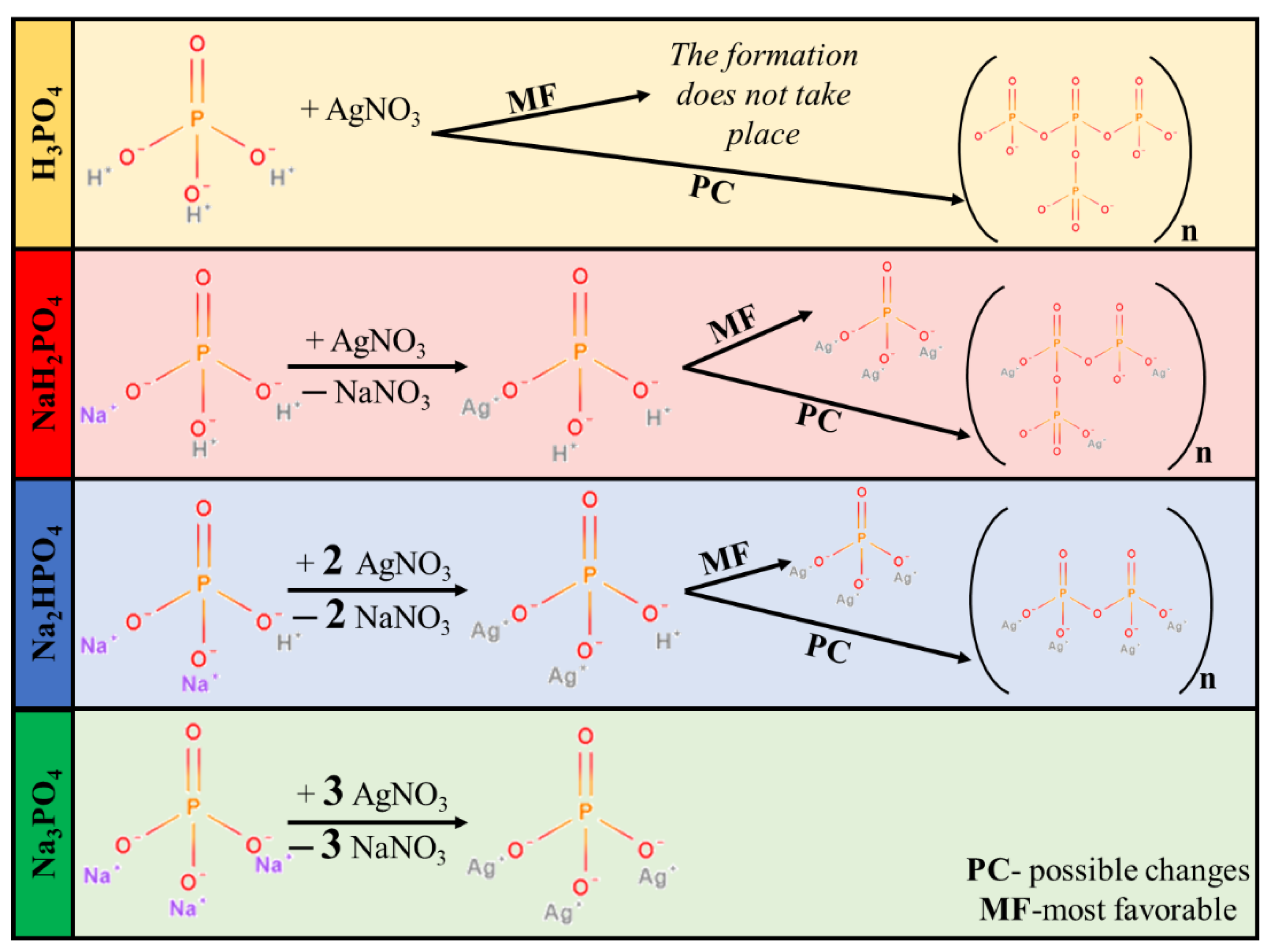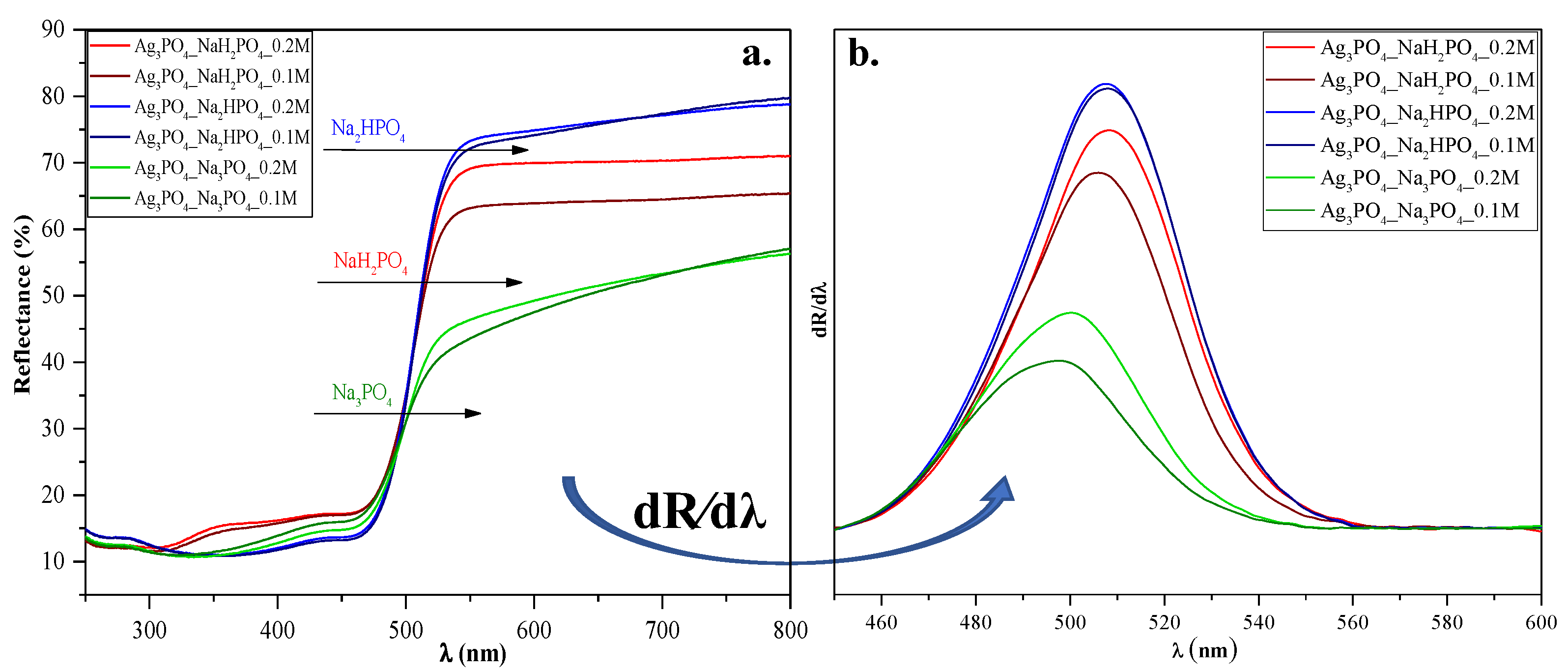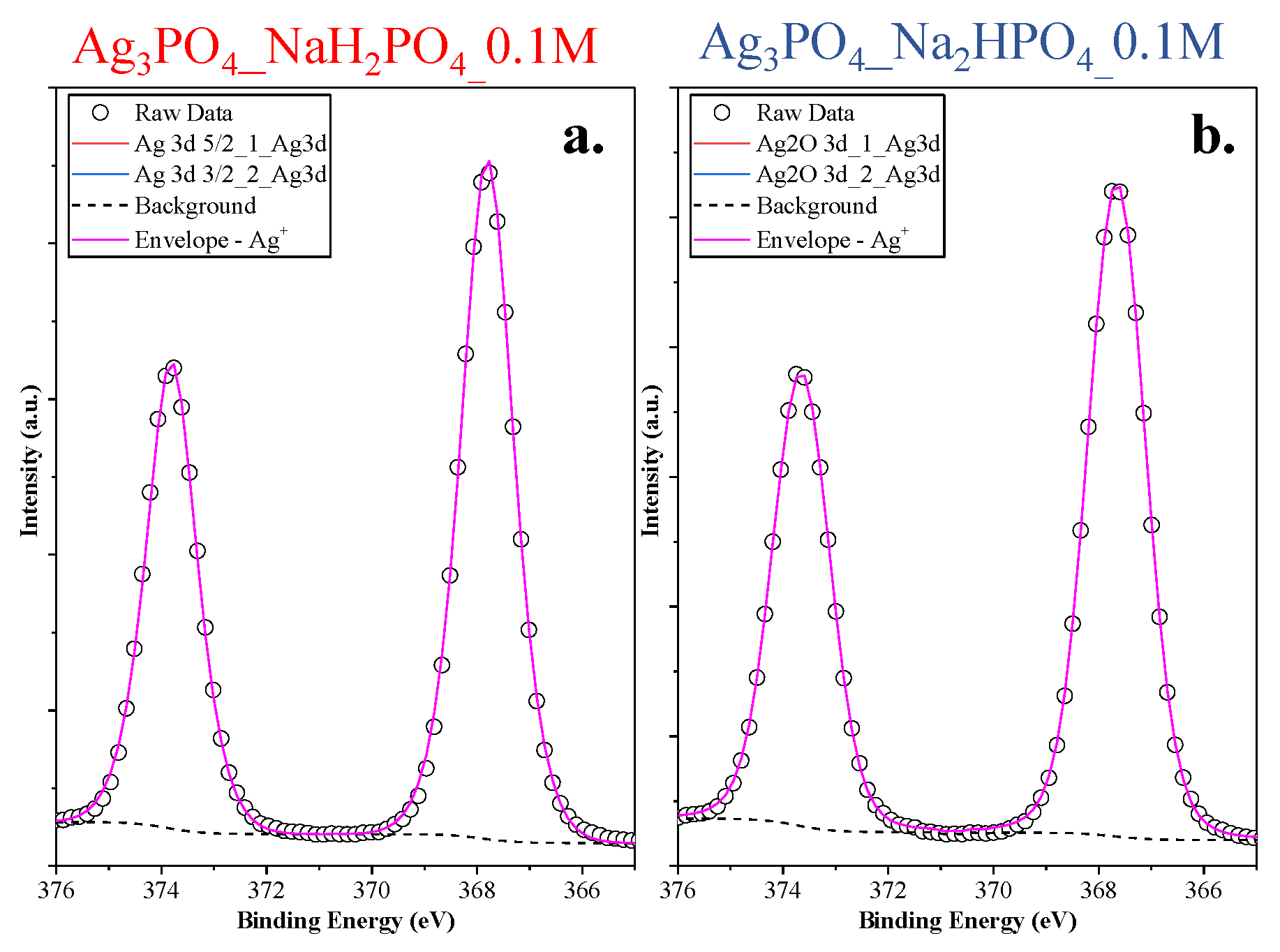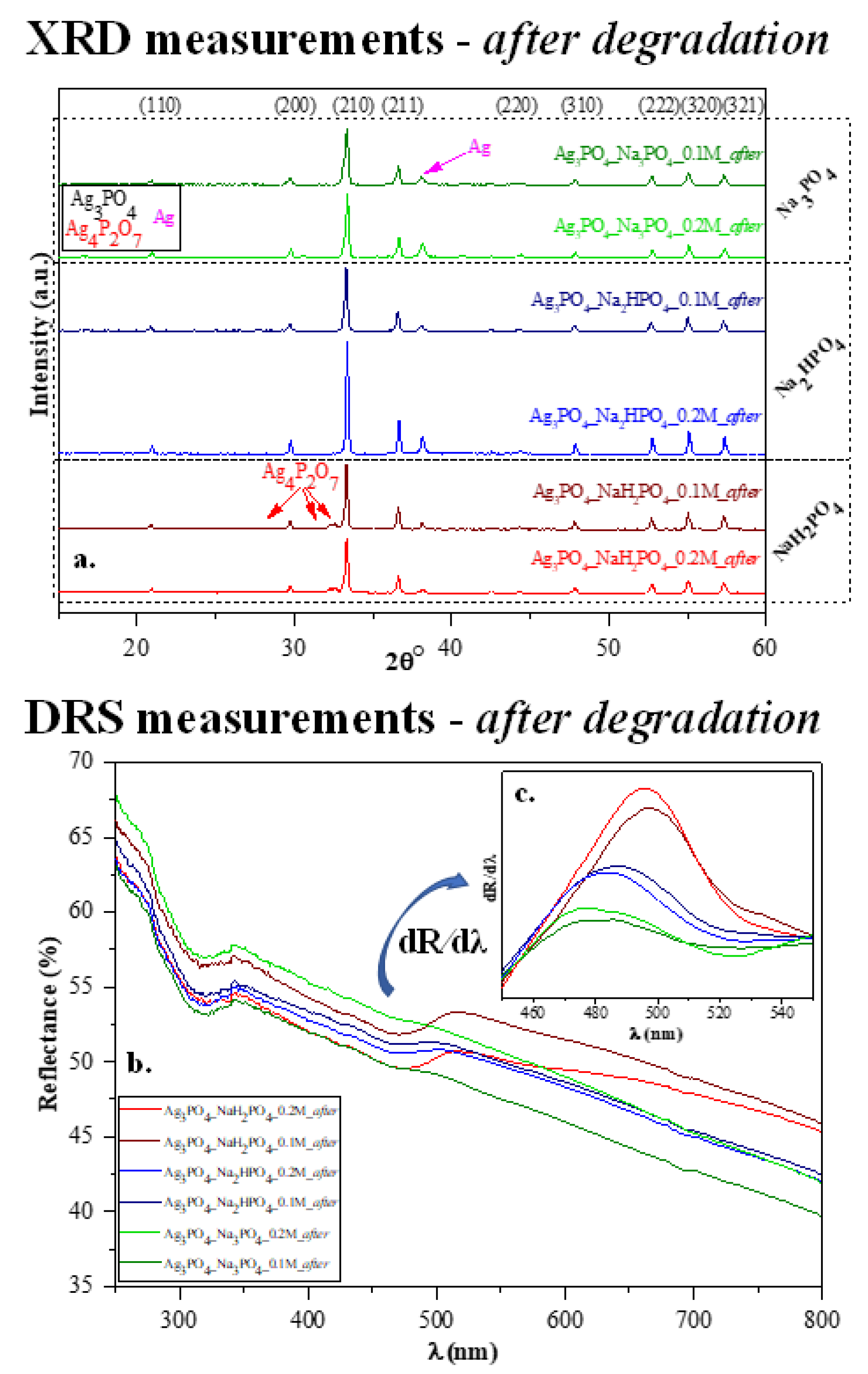Rapid Synthesis Method of Ag3PO4 as Reusable Photocatalytically Active Semiconductor
Abstract
1. Introduction
- The effect of different phosphate sources on the synthesis and photocatalytic activity of Ag3PO4. For this purpose, H3PO4, NaH2PO4, Na2HPO4, and Na3PO4 · 12H2O were used as phosphate sources. In this part, we propose a mechanism for the formation of Ag3PO4.
- Investigation of the stability of Ag3PO4 via recharacterization and reusability measurements.
- The effect of Ag nanoparticles on Ag3PO4, shown through the deposition mechanism of Ag nanoparticles. This aspect was demonstrated by photoluminescence measurements and their corresponding kinetic studies.
2. Materials and Methods
2.1. Materials
2.2. Methods
2.2.1. Synthesis of Ag3PO4 Semiconductors
2.2.2. Characterization and Instrumentation
2.2.3. Photocatalytic Activity
3. Results and Discussion
3.1. Characterization of Ag3PO4
3.2. Photocatalytic Degradation
3.3. Stability Investigation of Ag3PO4
3.3.1. Recharacterization of the Investigated Ag3PO4
3.3.2. Reusability of Ag3PO4 Samples: Recycling Tests and Photoluminescence Measurements
- Besides the Ag3PO4, only Ag4P2O7 was observed after the synthesis. Typical bands for surface oxygen vacancies and defects were also observed in the PL spectra.
- Two different pathways were observed using MO as a model pollutant, and the kinetics parameters changed after the first hour.
- The deposition of Ag nanoparticles was observed after MO degradation, which resulted in the lack of surface oxygen vacancies and defects.
4. Conclusions
Supplementary Materials
Author Contributions
Funding
Institutional Review Board Statement
Informed Consent Statement
Data Availability Statement
Conflicts of Interest
References
- al Kausor, M.; sen Gupta, S.; Chakrabortty, D. Ag3PO4-Based Nanocomposites and Their Applications in Photodegradation of Toxic Organic Dye Contaminated Wastewater: Review on Material Design to Performance Enhancement. J. Saudi Chem. Soc. 2020, 24, 20–41. [Google Scholar] [CrossRef]
- Ohtani, B.; Prieto-Mahaney, O.O.; Li, D.; Abe, R. What Is Degussa (Evonic) P25? Crystalline Composition Analysis, Reconstruction from Isolated Pure Particles and Photocatalytic Activity Test. J. Photochem. Photobiol. A Chem. 2010, 216, 179–182. [Google Scholar] [CrossRef]
- Feng, C.; Li, G.; Ren, P.; Wang, Y.; Huang, X.; Li, D. Effect of Photo-Corrosion of Ag2CO3 on Visible Light Photocatalytic Activity of Two Kinds of Ag2CO3/TiO2 Prepared from Different Precursors. Appl. Catal. B 2014, 158–159, 224–232. [Google Scholar] [CrossRef]
- Li, J.; Fang, W.; Yu, C.; Zhou, W.; Zhu, L.; Xie, Y. Ag-Based Semiconductor Photocatalysts in Environmental Purification. Appl. Surf. Sci. 2015, 358, 46–56. [Google Scholar] [CrossRef]
- Yi, Z.; Ye, J.; Kikugawa, N.; Kako, T.; Ouyang, S.; Stuart-Williams, H.; Yang, H.; Cao, J.; Luo, W.; Li, Z.; et al. An Orthophosphate Semiconductor with Photooxidation Properties under Visible-Light Irradiation. Nat. Mater. 2010, 9, 559–564. [Google Scholar] [CrossRef]
- Ma, X.; Lu, B.; Li, D.; Shi, R.; Pan, C.; Zhu, Y. Origin of Photocatalytic Activation of Silver Orthophosphate from First-Principles. J. Phys. Chem. C 2011, 115, 4680–4687. [Google Scholar] [CrossRef]
- Huang, G.F.; Ma, Z.L.; Huang, W.Q.; Tian, Y.; Jiao, C.; Yang, Z.M.; Wan, Z.; Pan, A. Ag3PO4 Semiconductor Photocatalyst: Possibilities and Challenges. J. Nanomater. 2013, 2013, 371356. [Google Scholar] [CrossRef]
- Ng, H.N.; Calvo, C.; Faggiani, R. A New Investigation of the Structure of Silver Orthophosphate. Acta Cryst. 1978, B34, 898–899. [Google Scholar] [CrossRef]
- Song, X.; Li, R.; Xiang, M.; Hong, S.; Yao, K.; Huang, Y. Morphology and Photodegradation Performance of Ag3PO4 Prepared by (NH4)3PO4, (NH4)2HPO4 and NH4H2PO4. Ceram. Int. 2017, 43, 4692–4701. [Google Scholar] [CrossRef]
- Amornpitoksuk, P.; Intarasuwan, K.; Suwanboon, S.; Baltrusaitis, J. Effect of Phosphate Salts (Na3PO4, Na2HPO4, and NaH2PO4) on Ag3PO4 Morphology for Photocatalytic Dye Degradation under Visible Light and Toxicity of the Degraded Dye Products. Ind. Eng. Chem. Res. 2013, 52, 17369–17375. [Google Scholar] [CrossRef]
- Qin, L.; Tao, P.; Zhou, X.; Pang, Q.; Liang, C.; Liu, K.; Luo, X. Synthesis and Characterization of High Efficiency and Stable Spherical Ag3PO4 Visible Light Photocatalyst for the Degradation of Methylene Blue Solutions. J. Nanomater. 2015, 2015, 258342. [Google Scholar] [CrossRef]
- Yang, Z.M.; Tian, Y.; Huang, G.F.; Huang, W.Q.; Liu, Y.Y.; Jiao, C.; Wan, Z.; Yan, X.G.; Pan, A. Novel 3D Flower-like Ag3PO4 Microspheres with Highly Enhanced Visible Light Photocatalytic Activity. Mater. Lett. 2014, 116, 209–211. [Google Scholar] [CrossRef]
- Raudoniene, J.; Skaudzius, R.; Zarkov, A.; Selskis, A.; Karlsson, O.; Kareiva, A.; Garskaite, E. Wet-Chemistry Synthesis of Shape-Controlled Ag3PO4 Crystals and Their 3D Surface Reconstruction from SEM Imagery. Powder Technol. 2019, 345, 26–34. [Google Scholar] [CrossRef]
- Krungchanuchat, S.; Ekthammathat, N.; Phuruangrat, A.; Thongtem, S.; Thongtem, T. High UV-Visible Photocatalytic Activity of Ag3PO4 Dodecahedral Particles Synthesized by a Simple Hydrothermal Method. Mater. Lett. 2017, 201, 58–61. [Google Scholar] [CrossRef]
- Dong, P.; Wang, Y.; Li, H.; Li, H.; Ma, X.; Han, L. Shape-Controllable Synthesis and Morphology-Dependent Photocatalytic Properties of Ag3PO4 Crystals. J. Mater. Chem. A Mater. 2013, 1, 4651–4656. [Google Scholar] [CrossRef]
- Bi, Y.; Hu, H.; Jiao, Z.; Yu, H.; Lu, G.; Ye, J. Two-Dimensional Dendritic Ag3PO4 Nanostructures and Their Photocatalytic Properties. Phys. Chem. Chem. Phys. 2012, 14, 14486–14488. [Google Scholar] [CrossRef]
- Dhanabal, R.; Chithambararaj, A.; Velmathi, S.; Bose, A.C. Visible Light Driven Degradation of Methylene Blue Dye Using Ag3PO4. J. Environ. Chem. Eng. 2015, 3, 1872–1881. [Google Scholar] [CrossRef]
- Tóth, Z.R.; Feraru, A.; Debreczeni, D.; Todea, M.; Popescu, R.A.; Gyulavári, T.; Sesarman, A.; Negrea, G.; Vodnar, D.C.; Hernadi, K.; et al. Influence of Different Silver Species on the Structure of Bioactive Silicate Glasses. J. Non Cryst. Solids 2022, 583, 121498. [Google Scholar] [CrossRef]
- Tauc, J. Optical Properties and Electronic Structure of Amorphous Ge and Si. Mat. Res. Bull. 1968, 3, 37–46. [Google Scholar] [CrossRef]
- da Pereira, W.S.; Gozzo, C.B.; Longo, E.; Leite, E.R.; Sczancoski, J.C. Investigation on the Photocatalytic Performance of Ag4P2O7 Microcrystals for the Degradation of Organic Pollutants. Appl. Surf. Sci. 2019, 493, 1195–1204. [Google Scholar] [CrossRef]
- Huang, K.; Lv, Y.; Zhang, W.; Sun, S.; Yang, B.; Chi, F.; Ran, S.; Liu, X. One-Step Synthesis of Ag3PO4/Ag Photocatalyst with Visible-Light Photocatalytic Activity. Mater. Res. 2015, 18, 939–945. [Google Scholar] [CrossRef]
- Zhang, W.; Zhou, L.; Shi, J.; Deng, H. Synthesis of Ag3PO4/g-C3N4 Composite with Enhanced Photocatalytic Performance for the Photodegradation of Diclofenac under Visible Light Irradiation. Catalysts 2018, 8, 45. [Google Scholar] [CrossRef]
- Zhang, M.; Li, Y.; Shi, Y.; Wang, Q.; Wang, A.; Gao, S. Effect of Blending Manner on Composition and Photocatalytic Performance of Ag/Ag3PO4/Ag4P2O7 Composites via an in-Situ Reduction-Precipitation Route. Inorg. Chem. Commun. 2021, 130, 108675. [Google Scholar] [CrossRef]
- Nie, C.; Dong, J.; Sun, P.; Yan, C.; Wu, H.; Wang, B. An Efficient Strategy for Full Mineralization of an Azo Dye in Wastewater: A Synergistic Combination of Solar Thermo- and Electrochemistry plus Photocatalysis. RSC Adv. 2017, 7, 36246–36255. [Google Scholar] [CrossRef]
- Putri, R.A.; Safni, S.; Jamarun, N.; Septiani, U. Kinetics Study and Degradation Pathway of Methyl Orange Photodegradation in the Presence of C-N-Codoped TiO2 Catalyst. Egypt. J. Chem. 2020, 63, 563–575. [Google Scholar] [CrossRef]
- Rodríguez-Cabo, B.; Rodríguez-Palmeiro, I.; Corchero, R.; Rodil, R.; Rodil, E.; Arce, A.; Soto, A. Photocatalytic Degradation of Methyl Orange, Methylene Blue and Rhodamine B with AgCl Nanocatalyst Synthesised from Its Bulk Material in the Ionic Liquid [P6 6 6 14]Cl. Water Sci. Technol. 2017, 75, 128–140. [Google Scholar] [CrossRef]
- Hou, M.; Li, F.; Liu, X.; Wang, X.; Wan, H. The Effect of Substituent Groups on the Reductive Degradation of Azo Dyes by Zerovalent Iron. J. Hazard. Mater. 2007, 145, 305–314. [Google Scholar] [CrossRef]
- Székely, I.; Baia, M.; Magyari, K.; Boga, B.; Pap, Z. The Effect of the PH Adjustment upon the WO3-WO3·0.33H2O-TiO2 Ternary Composite Systems’ Photocatalytic Activity. Appl. Surf. Sci. 2019, 490, 469–480. [Google Scholar] [CrossRef]
- Tóth, Z.R.; Hernadi, K.; Baia, L.; Kovács, G.; Pap, Z. Controlled Formation of Ag-AgxO Nanoparticles on the Surface of Commercial TiO2 Based Composites for Enhanced Photocatalytic Degradation of Oxalic Acid and Phenol. Catal. Today 2020. [Google Scholar] [CrossRef]
- Tóth, Z.R.; Pap, Z.; Kiss, J.; Baia, L.; Gyulavári, T.; Czekes, Z.; Todea, M.; Magyari, K.; Kovács, G.; Hernadi, K. Shape Tailoring of AgBr Microstructures: Effect of the Cations of Different Bromide Sources and Applied Surfactants. RSC Adv. 2021, 11, 9709–9720. [Google Scholar] [CrossRef]
- Batvandi, M.; Haghighatzadeh, A.; Mazinani, B. Synthesis of Ag3PO4 Microstructures with Morphology-Dependent Optical and Photocatalytic Behaviors. Appl. Phys. A Mater. Sci. Process. 2020, 126, 571. [Google Scholar] [CrossRef]
- Botelho, G.; Andres, J.; Gracia, L.; Matos, L.S.; Longo, E. Photoluminescence and Photocatalytic Properties of Ag3PO4 Microcrystals: An Experimental and Theoretical Investigation. Chempluschem 2016, 81, 202–212. [Google Scholar] [CrossRef] [PubMed]









| pH MPO4 | Band Gap Energy (eV) | λmax (nm) | đSEM (μm) | Conversion −2 h-(%) | |
|---|---|---|---|---|---|
| Ag3PO4_NaH2PO4_0.2M | 4.22 | 2.3 | 507 | n.a. | 38.98 |
| Ag3PO4_NaH2PO4_0.1M | 4.27 | 2.3 | 504 | n.a. | 49.53 |
| Ag3PO4_Na2HPO4_0.2M | 9.14 | 2.33 | 506 | 0.92 | 89.72 |
| Ag3PO4_Na2HPO4_0.1M | 9.24 | 2.34 | 506 | 0.97 | 88.80 |
| Ag3PO4_Na3PO4_0.2M | 11.46 | 2.27 | 498 | 0.58 | 95.94 |
| Ag3PO4_Na3PO4_0.1M | 11.71 | 2.22 | 495 | 0.33 | 94.53 |
| The colors of the samples are the same as those used in the entire article. | |||||
 First Hour → 0 Order |  Second Hour → 1 or 2 Order | |||||
|---|---|---|---|---|---|---|
| NaH2PO4//Na2HPO4//Na3PO4 →0th Order | NaH2PO4//Na2HPO4 →1st order Na3PO4 → 2nd Order | |||||
| Sample | Reaction Order (n) | k1 (μM∙min−1) | R2 | Reaction Order (n) | k2 (s−1) | R2 |
| Ag3PO4_NaH2PO4_0.1M | 0 | 0.3945 | 0.990 | 1 | 0.0063 | 0.988 |
| Ag3PO4-NaH2PO4-0.2M | 0 | 0.5626 | 0.991 | 1 | 0.0065 | 0.998 |
| Ag3PO4_Na2HPO4_0.1M | 0 | 1.0027 | 0.996 | 1 | 0.0244 | 0.996 |
| Ag3PO4_Na2HPO4_0.2M | 0 | 1.2889 | 0.997 | 1 | 0.0250 | 0.974 |
| Ag3PO4_Na3PO4_0.1M | 0 | 1.8342 | 0.996 | 2 | 0.0023 | 0.97 |
| Ag3PO4_Na3PO4_0.2M | 0 | 1.4366 | 0.993 | 2 | 0.0025 | 0.998 |
| Sample | Reaction order (n) | k1 (μM∙min−1) | R2 | Reaction order (n) | k2 (s−1/M−1) | R2 |
Disclaimer/Publisher’s Note: The statements, opinions and data contained in all publications are solely those of the individual author(s) and contributor(s) and not of MDPI and/or the editor(s). MDPI and/or the editor(s) disclaim responsibility for any injury to people or property resulting from any ideas, methods, instructions or products referred to in the content. |
© 2022 by the authors. Licensee MDPI, Basel, Switzerland. This article is an open access article distributed under the terms and conditions of the Creative Commons Attribution (CC BY) license (https://creativecommons.org/licenses/by/4.0/).
Share and Cite
Tóth, Z.-R.; Debreczeni, D.; Gyulavári, T.; Székely, I.; Todea, M.; Kovács, G.; Focșan, M.; Magyari, K.; Baia, L.; Pap, Z.; et al. Rapid Synthesis Method of Ag3PO4 as Reusable Photocatalytically Active Semiconductor. Nanomaterials 2023, 13, 89. https://doi.org/10.3390/nano13010089
Tóth Z-R, Debreczeni D, Gyulavári T, Székely I, Todea M, Kovács G, Focșan M, Magyari K, Baia L, Pap Z, et al. Rapid Synthesis Method of Ag3PO4 as Reusable Photocatalytically Active Semiconductor. Nanomaterials. 2023; 13(1):89. https://doi.org/10.3390/nano13010089
Chicago/Turabian StyleTóth, Zsejke-Réka, Diána Debreczeni, Tamás Gyulavári, István Székely, Milica Todea, Gábor Kovács, Monica Focșan, Klara Magyari, Lucian Baia, Zsolt Pap, and et al. 2023. "Rapid Synthesis Method of Ag3PO4 as Reusable Photocatalytically Active Semiconductor" Nanomaterials 13, no. 1: 89. https://doi.org/10.3390/nano13010089
APA StyleTóth, Z.-R., Debreczeni, D., Gyulavári, T., Székely, I., Todea, M., Kovács, G., Focșan, M., Magyari, K., Baia, L., Pap, Z., & Hernadi, K. (2023). Rapid Synthesis Method of Ag3PO4 as Reusable Photocatalytically Active Semiconductor. Nanomaterials, 13(1), 89. https://doi.org/10.3390/nano13010089














